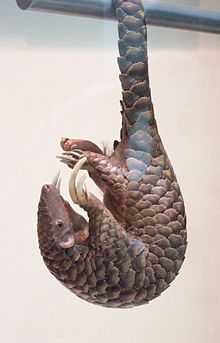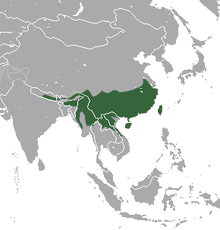Chinese pangolin
| Chinese pangolin | |
|---|---|
 | |
| Conservation status | |
| Scientific classification | |
| Kingdom: | Animalia |
| Phylum: | Chordata |
| Class: | Mammalia |
| Order: | Pholidota |
| Family: | Manidae |
| Genus: | Manis |
| Species: | M. pentadactyla |
| Binomial name | |
| Manis pentadactyla Linnaeus, 1758 [2] | |
 | |
| Chinese pangolin range | |
The Chinese pangolin (Manis pentadactyla) is a pangolin found in northern India, Nepal, Bhutan, possibly Bangladesh, across Myanmar to northern Indochina, through most of Taiwan and southern China, including the islands of Hainan.[3]
The Chinese pangolin can dig up to 8 ft (2.5 m) deep in the ground with its strong and clawed fore feet, in four to five minutes. Once it enters the burrow, it blocks the opening. Some Chinese pangolins occupy burrows of other animals, as well. Its body mass is about 3.6 kg (8.0 lbs). {below it claims less}
The Chinese pangolin appears like a scaly anteater. From head to body, it measures around 60 cm (24 in) and its tail measures about 18 cm (7 in). A mature Chinese pangolin weighs about 2.4 kg (82.7 oz) (above it claims more). A newborn pangolin weighs about 93 g (3.3 oz) (below it claims more). It has 18 rows of overlapping scales accompanied by hair, a rare combination in mammals. It has a small, narrow mouth and a little, pointed head. Its nose is plump, with nostrils at its end. This is a bronze-colored animal, with a round body equipped with extremely sharp claws.
The Chinese pangolin found in Nepal reproduces in April and May when the weather is a bit warm. The female gives birth to a single young at a time, and it weighs about 1 lb (450 g) (above it claims less) and its length is about 45 cm (18 in). The young also has scales which remain very soft for two days. Although the young pangolin can walk on its very first day, the mother carries it on her back or tail. If the mother feels threatened, she immediately folds her baby onto her belly with the help of her tail. Male pangolins have been noticed to show extraordinary parental instinct and allow the female and baby to share the burrow.

Chinese pangolins are rather secretive, nocturnal creatures. They move very slowly and are known for their nonaggressive behavior. Their hard scales work as a protective cover from predators, and when they feel endangered, they curl themselves into balls. Chinese pangolins are mainly terrestrial animals, but are observed in forests up to about 20 feet above the ground.
They mainly eat insects, such as termites and ants. Their sharp claws help them in digging up the ants and termite mounds and with the help of their sticky, long (25-cm) tongues, they can draw their prey into their mouths.
In Vietnam and Hong Kong, Chinese pangolins are considered a delicacy, and they are hunted on a large scale only for this purpose. Now, Chinese pangolins are being protected in the forests where they are generally found. Factors such as habitat destruction and hunting constantly challenge their survival. Since the forests they inhabit are difficult to patrol, hunters can hunt these animals without being caught.
Conservation
In Hong Kong, it is a protected species under the Wild Animals Protection Ordinance Cap 170. The IUCN stated, "The populations have been greatly reduced in the last 15 years (generation length estimated at 5 years), and decline suspected to continue over the next 15 years, at a rate of over 50%. The species is thus listed as Endangered A2d+3d+4d." [4]
"The Critter"

The Chinese pangolin is probably "The Critter", one of the pets of the Raven FACs at their secret base in Long Tieng during the covert war in Laos. It was described as a foot-long "prehistoric" beast, covered in armor plating with a long tail and a pointed nose, a "cross between a sloth and an armadillo", by the US pilots.
After its accidental death, The Critter's body was preserved in a one-gallon jar filled with alcohol. A picture taken of the preserved animal was sent to the Smithsonian Institution in Washington, DC, as well as to the Natural History department of La Sorbonne in Paris, but no positive reply was forthcoming. For a long time, nobody knew what kind of animal it was until one of the pilots stationed in Laos happened to see the animal on a Laotian postage stamp, part of a stamp series on indigenous animals from Laos, under the name "Panis Auritas".[5]
See also
- List of mammals in Hong Kong
- List of mammals in Taiwan
References
- ↑ Duckworth, J.W., Steinmitz, R., Anak Pattanavibool, Than Zaw, Do Tuoc & Newton, P. (2008). Manis pentadactyla. In: IUCN 2008. IUCN Red List of Threatened Species. Retrieved 2008-10-16.
- ↑ Linnæus, Carl (1758). Systema naturæ per regna tria naturæ, secundum classes, ordines, genera, species, cum characteribus, differentiis, synonymis, locis. Tomus I (in Latin) (10 ed.). Holmiæ: Laurentius Salvius. p. 36. Retrieved 23 November 2012.
- ↑ Schlitter, D. A. (2005). "Order Pholidota". In Wilson, D. E.; Reeder, D. M. Mammal Species of the World (3rd ed.). Johns Hopkins University Press. p. 530. ISBN 978-0-8018-8221-0. OCLC 62265494.
- ↑ IUCN Red List - Manis pentadactyla
- ↑ Christopher Robbins, The Ravens: Pilots of the Secret War in Laos. Asia Books 2000.
External links
- EDGE of Existence (Chinese pangolin) – Saving the World's most Evolutionarily Distinct and Globally Endangered (EDGE) species
- ADW entry
- Jung-Tai Chao. General Status of Formosan Pangolin Manis pentadactyla pentadactyla
- Cryptozoology - The Critter
| Wikispecies has information related to: Manis pentadactyla |
| |||||||||||||||||||||||||
